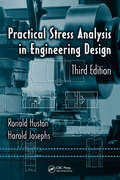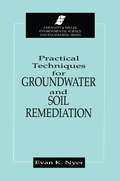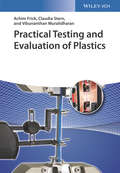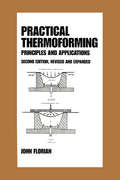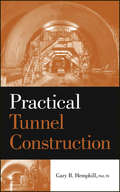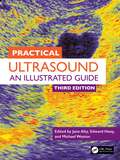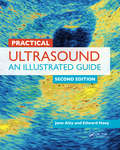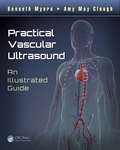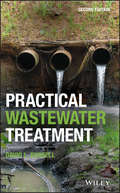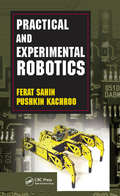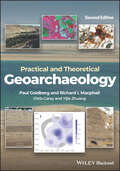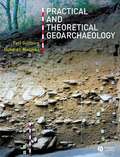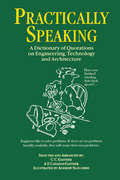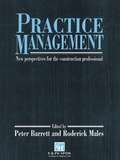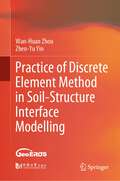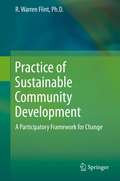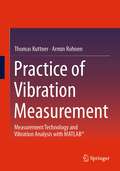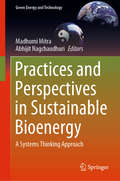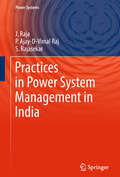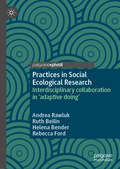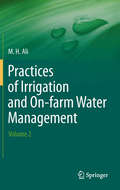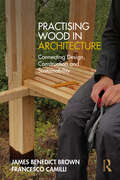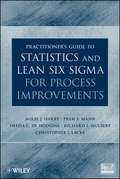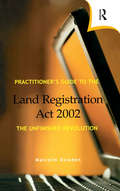- Table View
- List View
Practical Stress Analysis in Engineering Design (Mechanical Engineering)
by Harold Josephs Ronald HustonUpdated and revised, this book presents the application of engineering design and analysis based on the approach of understanding the physical characteristics of a given problem and then modeling the important aspects of the physical system. This third edition provides coverage of new topics including contact stress analysis, singularity functions,
Practical Techniques for Groundwater & Soil Remediation
by Evan K. NyerPractical Techniques for Groundwater and Soil Remediation is a compilation of articles by the author that were printed in the National Ground Water Association (NGWA) magazine Groundwater Monitoring Review. The book provides valuable data, emphasizes the practical aspects of remediation, presents results from actual remediation programs, and helps readers prepare remediation strategies. The book also includes detailed technical data on treatment equipment performance and the costs associated with their design and operation. A unique feature of the book is that it also contains data from treatment systems that did not work.Practical Techniques for Groundwater and Soil Remediation is a "must have" source of invaluable data and tips that will be useful for all groundwater and soil remediation professionals.
Practical Testing and Evaluation of Plastics
by Achim Frick Claudia Stern Vibunanthan MuralidharanFilling a need, this ready reference brings together the hard-to-get and recently acquired knowledge usually only found scattered in the original literature. <P><P> Following an introduction to plastics as a class of engineering materials and an overview of their properties, the book comprehensively covers the characterization and quality control of manufactured plastic components, including an exhaustive treatment of the possible flaws of plastics inadvertently introduced during manufacturing along with viable solutions to prevent these faults. The second part is concerned with the testing of the resulting end products by various physical and chemical methods on the nano-, meso- and macroscale. An appendix with thermoanalytic data and international standards for the most commonly used polymers in plastics engineering rounds off the text. <P><P> Written by experienced academics and industrial researchers and developers who intimately know the problems faced by plastics engineers in their daily work - as well as the solutions - this book provides first-hand practical knowledge and in-depth discussions for industrial chemists and materials scientists alike.
Practical Thermoforming: Principles and Applications
by John FlorianProvides in-depth coverage of the entire thermoforming molding process from market domain and materials options to manufacturing methods and peripheral support. Second Edition furnishes entirely new information on twin sheet forming, corrugated tubing and pipe manufacturin gtechniques, plastics recycling, forthcoming equipment, and energy and labor costs.
Practical Tunnel Driving
by Gary B. HemphillThe only modern guide to all aspects of practical tunnel construction Practical Tunnel Construction fills a void in the literature for a practical guide to tunnel construction. By taking the reader through a brief introduction and history to a comprehensive discussion of how the geological factors affect tunneling, the author covers the stages and technology that are common today without using complex equations. Written for the individual who does not have an extensive background in tunneling but who has to make tunneling decisions, the various tunneling methods are discussed to help in the determination of the appropriate method. The methods discussed are: hand mining, drill/blast, Tunnel Boring Machine (TBM), New Austrian Tunnelling Method (NATM), Norwegian Method of Tunnelling (NMT), Roadheader, Earth Pressure Balance Machine (EPBM), and Slurry Pressure Balance Machine (SPBM). This book focuses on driven tunnels. This versatile handbook: Offers clear and accessible coverage of the state of the art in tunnel construction Introduces the essentials of design and construction of many types of tunnels, including TBM, EPB, Roadheader, NATM, drill and blast, and soft ground tunneling Provides nontechnical guidance on selecting the most appropriate tunneling methods for various situations Includes a brief history of tunneling and an introduction to geotechnical considerations Discusses tunnel access shaft construction, mucking methods, tunnel haulage, grout, water handling, and much more Practical Tunnel Construction is an important resource for students, construction managers, tunnel designers, municipal engineers, or engineers who are employed by government agencies or corporations that are exploring the feasibility of planning and designing or building a tunnel.
Practical Ultrasound: An Illustrated Guide
by Michael Weston Jane Alty Edward HoeyIn the hands of a skilled operator, ultrasound scanning is a simple and easy procedure. However, reaching that level of proficiency can be a long and tedious process. Commended by the British Medical Association, Practical Ultrasound, Third Edition incorporates up-to-date techniques and protocols, focusing on the scans regularly encountered in a busy ultrasound department. This book provides everything novice practitioners need to know to become competent and skilled in scanning.Beginning with the general principles of ultrasound scanning and a guide to using the ultrasound machine, this book provides clear instructions on how to perform scans supplemented by high-quality images and handy tips. Organized according to anatomical site, the chapters include a review section on useful anatomy, scan protocol presented step by step, and a section on common pathology. Maintaining the popular format of the first and second editions, each chapter contains examples of common and clinically relevant pathologies and notes on the salient features of these conditions.The authors’ precise approach puts an immense amount of knowledge within easy reach, making it an ideal aid for learning the practicalities of ultrasound.Key Features: Follows an appealing organization of chapters, developing fundamental knowledge of how to operate the ultrasound machine before moving on to the practicalities of how to scan each anatomical area Presents comprehensive, authoritative, and up‑to‑date text, integrating anatomical knowledge, practical tips from experts, and common clinical pathologies that are important to recognize Incorporates high‑quality ultrasound images with corresponding line drawings indicating the key points to spot Arms you with the practical knowledge you will need when you pick up the ultrasound probe and start out on your own journey of learning the skill of ultrasonography
Practical Ultrasound: An Illustrated Guide, Second Edition
by Jane Alty Edward HoeyIn the hands of a skilled operator, ultrasound scanning is a simple and easy procedure. However, reaching that level of proficiency can be a long and tedious process. Commended by the British Medical Association, Practical Ultrasound, Second Edition focuses on the scans regularly encountered in a busy ultrasound department and provides everything p
Practical Vascular Ultrasound: An Illustrated Guide
by Kenneth Myers Amy May CloughUltrasound is used to demonstrate and classify numerous vascular diseases and provides a firm basis for deciding the most appropriate interventional treatment. Practical Vascular Ultrasound: An Illustrated Guide delivers a hands-on, practical approach to the diagnosis of vascular disease. Providing an overview of performing vascular ultrasounds, th
Practical Wastewater Treatment
by David L. RussellThe updated and expanded guide for handling industrial wastes and designing a wastewater treatment plant The revised and updated second edition of Practical Wastewater Treatment provides a hands-on guide to industrial wastewater treatment theory, practices, and issues. It offers information for the effective design of water and wastewater treatment facilities and contains material on how to handle the wide-variety of industrial wastes. The book is based on a course developed and taught by the author for the American Institute of Chemical Engineers. The author reviews the most current industrial practices and goals, describes how the water industry works, and covers the most important aspects of the industry. In addition, the book explores a wide-range of approaches for managing industrial wastes such as oil, blood, protein and more. A comprehensive resource, the text covers such basic issues as water pollution, wastewater treatment techniques, sampling and measurement, and explores the key topic of biological modeling for designing wastewater treatment plants. This important book: Offers an updated and expanded text for dealing with real-world wastewater problems Contains new chapters on: Reverse Osmosis and desalination; Skin and Membrane Filtration; and Cooling tower water treatment Presents a guide filled with helpful examples and diagrams that is ideal for both professionals and students Includes information for handling industrial wastes and designing water and wastewater treatment plants Written for civil or chemical engineers and students, Practical Wastewater Treatment offers the information and techniques needed to solve problems of wastewater treatment.
Practical and Experimental Robotics: Introduction To Ros And Solidworks, Second Edition
by Pushkin Kachroo Ferat SahinTaking a completely hands-on approach, using cheap and easily available robotics kits, Practical and Experimental Robotics provides a detailed exploration of the construction, theory, and experiments for different types of robots. With topics ranging from basic stamp microcontrollers to biped and propeller based robots, the text contains laboratory experiments, examples with solutions, and case studies. The authors begin with a review of the essential elements of electronics and mechanics. They describe the basic mechanical construction and electrical control of the robot, then give at least one example of how to operate the robot using microcontrollers or software. The book includes a reference chapter on Basic Stamp Microcontollers with example code pieces and a chapter completely devoted to PC interfacing. Each chapter begins with the fundamentals, then moves on to advanced topics, thus building a foundation for learning from the ground up. Building a bridge between technicians who have hands-on experience and engineers with a deeper insight into the workings, the book covers a range of machines, from arm, wheel, and leg robots to flying robots and robotic submarines and boats. Unlike most books in this field, this one offers a complete set of topics from electronics, mechanics, and computer interface and programming, making it an independent source for knowledge and understanding of robotics.
Practical and Theoretical Geoarchaeology
by Paul Goldberg Richard I. Macphail Chris Carey Yijie ZhuangPractical and Theoretical Geoarchaeology, Second Edition, provides an invaluable and vastly updated overview of geoarchaeology and how it can be used effectively in the study of archaeological sites and contexts. Taking a pragmatic and functional approach, this book presents: a fundamental, broad-based perspective of the essentials of modern geoarchaeology in order to demonstrate the breadth of the approaches and the depth of the problems that it can tackle. the rapid advances made in the area in recent years, but also gives the reader a firm grasp of conventional approaches. covers traditional topics with the emphasis on landscapes, as well as anthropogenic deposits and site formation processes and their investigation. provides guidelines for the presentation of field and laboratory methods and the reporting of geoarchaeological results. essential reading for archaeology undergraduate and graduate students, practicing archaeologists and geoscientists who need to understand and apply geoarchaeological methodologies, and help foster the dialog among diverse researchers investigating archaeological sites. Practical and Theoretical Geoarchaeology, Second Edition, is an ideal resource for undergraduate and graduate students in archaeology, and a great practical reference for practicing archaeologists and geoscientists who need to understand and apply geoarchaeological methodologies internationally.
Practical and Theoretical Geoarchaeology
by Paul Goldberg Richard I. MacphailPractical and Theoretical Geoarchaeology provides an invaluable overview of geoarchaeology and how it can be used effectively in the study of archaeological sites and contexts. <P><P>Taking a pragmatic and functional approach, this book presents: a fundamental, broad-based perspective of the essentials of modern geoarchaeology in order to demonstrate the breadth of the approaches and the depth of the problems that it can tackle. the rapid advances made in the area in recent years, but also gives the reader a firm grasp of conventional approaches. covers traditional topics with the emphasis on landscapes, as well as anthropogenic site formation processes and their investigation. provides guidelines for the presentation of field and laboratory methods and the reporting of geoarchaeological results. essential reading for archaeology undergraduate and graduate students, practicing archaeologists and geoscientists who need to understand and apply geoarchaeological methodologies. Artwork from the book is available to instructors online at: www.blackwellpublishing.com/goldberg "This is one of the best textbooks that I have read in years. I enjoyed reviewing it, and found it well-written and thorough in its coverage of the traditional earth science aspects of geoarchaeology. The non-traditional aspects were intriguing and equally thorough... I predict that this book will become the textbook of choice for geoarchaeology classes for several years." Geomorphology 101 (2008) 740-743
Practically Speaking: A Dictionary of Quotations on Engineering, Technology and Architecture
by C.C. Gaither Alma E Cavazos-GaitherThis book brings together over 1,100 quotes pertinent and illuminating to engineering, technology and architecture. It includes extensive author and subject indexes for locating quotations. The book can be read for entertainment or used as a handy reference by students and professional engineers.
Practice Management for Land, Construction and Property Professionals
by Brian GreenhalghPractice management for Land, Construction and Property Professionals presents the expert views and practical experience of researchers and practitioners concerned with the particular challenges and skills required to manage professional service organizations in the constuction and property industries. The book provides extensive coverage of the following key issues: management of creativity marketing of professional services professional ethics quality management business planning and strategic management Practice management for land, Construction and Property Professionals will be an important guide for those with management responsibiliie in the property and construction industries. Students working towards qualifications in the properrty and construction professions will also find the book a valuable reference and source of advice.
Practice Management: New perspectives for the construction professional
by Peter Barrett Roderick MalesFirst Published in 2004. Routledge is an imprint of Taylor & Francis, an informa company.
Practice of Discrete Element Method in Soil-Structure Interface Modelling
by Zhen-Yu Yin Wan-Huan ZhouThis book is related to a parametric study of the soil–structural interface shearing behavior based on the numerical simulations of interface shear test with DEM, which is conducted from the role of soil properties, particle properties and structural properties. To aid readers in easily understanding the generation, implementation of models and controlling modes, for each part, the relevant code is provided in the text, and the whole source code of model is given in Appendix to share with readers for practice. The book is intended for graduate-level teaching and research in soil mechanics and geotechnical engineering, as well as in other related engineering specialties. This book is also of use to industry practitioners due to the inclusion of real-world applications, opening the door to advanced courses on modeling within the industrial engineering and operations research fields.
Practice of Sustainable Community Development
by R. Warren FlintOrdinary people, community leaders, and even organizations and corporations still do not fully comprehend the interconnected, "big picture" dynamics of sustainability theory and action. In exploring means to become more sustainable, individuals and groups need a reference in which to frame discussions so they will be relevant, educational, and successful when implemented. This book puts ideas on sustainable communities into a conceptual framework that will promote striking, transformational effects on decision-making. In this book practitioners and community leaders will find effective, comprehensive tools and resources at their finger-tips to facilitate sustainable community development (SCD). The book content examines a diverse range of SCD methods; assessing community needs and resources; creating community visions; promoting stakeholder interest and participation; analyzing community problems; designing and facilitating strategic planning; carrying out interventions to improve
Practice of Vibration Measurement: Measurement Technology and Vibration Analysis with MATLAB®
by Thomas Kuttner Armin RohnenThis technical book deals with the design and function of vibration measurement systems, how they are put into operation and how measurements are interpreted. It describes the functioning of the entire measurement chain from the transducer to the evaluation, and explains the interaction of the elements as well as the practically used procedures of signal processing and evaluation and clarifies them with numerous practical examples.
Practices and Perspectives in Sustainable Bioenergy: A Systems Thinking Approach (Green Energy and Technology)
by Madhumi Mitra Abhijit NagchaudhuriThis book presents a systems approach to bioenergy and provides a means to capture the complexity of bioenergy issues, including both direct and indirect impacts across the energy economy. The book addresses critical topics such as systems thinking; sustainability, biomass; feedstocks of importance and relevance (that are not competing with the food market); anaerobic digestion and biogas; biopower and bioheat; and policies, economy, and rights to access to clean energy. This is a contributed volume with each chapter written by relevant experts in the respective fields of research and teaching. Each chapter includes a review with highlights of the key points, critical-thinking questions, and a glossary.This book can be used as a primary or secondary textbook in courses related to bioenergy and bioproducts and sustainable biofuels. It is suitable for advanced undergraduate and graduate students. Researchers, professionals, and policy makers will also be able to use this book for current reference materials.
Practices in Power System Management in India (Power Systems)
by J Raja P Ajay-D-Vimal Raj S RajasekarThis book presents the state-of-the-art methods and procedures necessary for operating a power system. It takes into account the theoretical investigations and practical considerations of the modern electrical power system. It highlights in a systematic way the following sections: Power Sector Scenario in India, Distribution Planning and Optimization, Best practices in Operation & Maintenance of Sub-Transmission & Distribution Lines, Best Practices in Operation and Maintenance of Distribution Substation Equipment’s and Auxiliaries, Best Practice in Operation & Maintenance of Transformer and Protection Systems, International Best Practices in Operation & Maintenance (Advanced Gadgets), Aerial Bunch Conductor (ABC) based Distribution System, Best Practices in Operation & Maintenance of Energy Meters.
Practices in Social Ecological Research: Interdisciplinary collaboration in 'adaptive doing'
by Helena Bender Andrea Rawluk Ruth Beilin Rebecca FordAimed at those at the forefront of social ecological thinking, this book presents a practice-oriented process to navigate the complex, interdisciplinary challenges of our time. The book brings together insights from the social sciences and beyond to introduce readers to ‘adaptive doing’ - a continuous and iterative process of experiential learning that provides an accessible structure and process for integrating a range of knowledge and practices. As part of the ‘adaptive doing’ learning cycle, the authors argue for a common platform, symbolically called ‘the agora’, where multiple ways of understanding can be discussed. In this space, participants can work from practice and narratives, toward meaning, knowledge formation and practice change.The book demonstrates three reframing tools for social ecological practice that provide readers with multiple ways of holistically entering the social ecological domain and expanding their perspectives with a view to changing practice. ‘Adaptive doing’ is presented as a catalyst for a new generation of social ecological research, in which participants honour their disciplinary foundations while being ready to collaborate within each new system, and each new engagement: being able to act now, for social ecological recognition and change.
Practices of Irrigation & On-farm Water Management: Volume 2
by Hossain AliThe comprehensive and compact presentation in this book is the perfect format for a resource/textbook for undergraduate students in the areas of Agricultural Engineering, Biological Systems Engineering, Bio-Science Engineering, Water Resource Engineering, and Civil & Environmental Engineering. This book will also serve as a reference manual for researchers and extension workers in such diverse fields as agricultural engineering, agronomy, ecology, hydrology, and meteorology.
Practising Wood in Architecture: Connecting Design, Construction and Sustainability
by James Benedict Brown Francesco CamilliIn the stark light of the climate emergency, using wood instead of concrete, steel, or masonry is increasingly seen as a way of reducing the environmental impact of architecture and construction. More and more new buildings are showcasing innovative ways to work with wood. Wood can help architects achieve ambitious sustainability targets, including the United Nations’ Sustainable Development Goals.How can architects, student architects, and those in the construction industry better understand the qualities, characteristics, and possibilities of building with wood? Practising Wood in Architecture explores the methods, philosophies, and possibilities of contemporary teaching practices in architecture. This book explores how architecture students are learning to build with wood and interrogates the consequences for architectural practice.Based on original research conducted over two years, the book explores innovative projects that use wood in China, England, Finland, Germany, Mongolia, South Africa, and Switzerland. These case studies demonstrate the many advantages of wood, including its simplicity of use, its affordability, and its sustainability. The book focuses on ongoing initiatives that show the educational and professional impact of the use of wood in architecture and construction by students and professionals alike.
Practitioner's Guide to Statistics and Lean Six Sigma for Process Improvements
by Christopher J. Lacke Richard L. Hulbert Prem S. Mann Mikel J. Harry Ofelia C. De HodginsThis hands-on book presents a complete understanding of Six Sigma and Lean Six Sigma through data analysis and statistical conceptsIn today's business world, Six Sigma, or Lean Six Sigma, is a crucial tool utilized by companies to improve customer satisfaction, increase profitability, and enhance productivity. Practitioner's Guide to Statistics and Lean Six Sigma for Process Improvements provides a balanced approach to quantitative and qualitative statistics using Six Sigma and Lean Six Sigma methodologies.Emphasizing applications and the implementation of data analyses as they relate to this strategy for business management, this book introduces readers to the concepts and techniques for solving problems and improving managerial processes using Six Sigma and Lean Six Sigma. Written by knowledgeable professionals working in the field today, the book offers thorough coverage of the statistical topics related to effective Six Sigma and Lean Six Sigma practices, including:Discrete random variables and continuous random variablesSampling distributionsEstimation and hypothesis testsChi-square testsAnalysis of varianceLinear and multiple regressionMeasurement analysisSurvey methods and sampling techniquesThe authors provide numerous opportunities for readers to test their understanding of the presented material, as the real data sets, which are incorporated into the treatment of each topic, can be easily worked with using Microsoft Office Excel, Minitab, MindPro, or Oracle's Crystal Ball software packages. Examples of successful, complete Six Sigma and Lean Six Sigma projects are supplied in many chapters along with extensive exercises that range in level of complexity. The book is accompanied by an extensive FTP site that features manuals for working with the discussed software packages along with additional exercises and data sets. In addition, numerous screenshots and figures guide readers through the functional and visual methods of learning Six Sigma and Lean Six Sigma.Practitioner's Guide to Statistics and Lean Six Sigma for Process Improvements is an excellent book for courses on Six Sigma and statistical quality control at the upper-undergraduate and graduate levels. It is also a valuable reference for professionals in the fields of engineering, business, physics, management, and finance.
Practitioner's Guide to the Land Registration Act 2002
by Malcolm DowdenKey provisions of the Land Registration Act 2002 provide the legal framework for electronic conveyancing. This book will explain the legislative framework and the current proposals – including the key issues of security and authorisation – and will highlight the points that need to be addressed by practitioners in order to qualify for access to the new system.Electronic conveyancing will not be with us until 2006 and this book will take a thematic approach, highlighting the main practical issues arising from the new law and providing precedents and checklists to help busy conveyancers to manage the risks. This book will seek to highlight – and to give practical advice on – the day to day requirements of the new regime, and to promote sensible and cost-effective management of the risks.
